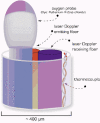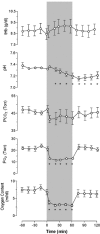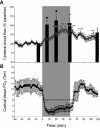Fetal lamb cerebral blood flow (CBF) and oxygen tensions during hypoxia: a comparison of laser Doppler and microsphere measurements of CBF
- PMID: 12563011
- PMCID: PMC2342576
- DOI: 10.1113/jphysiol.2002.025270
Fetal lamb cerebral blood flow (CBF) and oxygen tensions during hypoxia: a comparison of laser Doppler and microsphere measurements of CBF
Abstract
This study was undertaken to compare microsphere and laser Doppler flowmetry techniques for the measurement of cerebral blood flow, to assess the effect of probe implantation at the tip of the sensing probe and to measure brain tissue P(O2) (tP(O2)) in response to acute hypoxia. Fetal sheep of ~131 days gestation (n = 8) were chronically instrumented with bilateral laser Doppler probes in the parietal cortices and catheters for injection of fluorescent microspheres. Five days after surgery fetuses were subjected to 1 h periods of baseline control breathing, hypoxia and recovery. Microspheres were injected 10 min prior to and 10, 30, 50 and 120 min after initiation of hypoxia. Microspheres were counted in four 12 mm(3) tissue samples from each hemisphere, the tip of the laser Doppler probe being positioned in the centre of one of the cubes. The cube containing the probe tip was also subdivided into 4 mm(3) pieces of tissue. In response to hypoxia, fetal arterial P(O2) declined from 21 +/- 2 to 12 +/- 1 Torr and brain tissue P(O2) fell from 10 +/- 1 to a nadir of 1 +/- 1 Torr. Each method detected a significant increase in CBF that reached a maximum after 30-45 min, although the increase of flow measured by laser Doppler flowmetry was less than that measured by spheres after 10 and 30 min (P < 0.05). Microspheres did not detect altered flow at the probe tip or heterogeneity of flow in surrounding volumes of cortical tissue. In summary, laser Doppler flowmetry is a useful measure of continuous relative changes of CBF in the chronically instrumented fetal sheep. Flow compensations in acute hypoxia are not adequate to sustain O(2) delivery, and other compensations, including reduced metabolic rate, are possible.
Figures








Similar articles
-
Cerebral metabolism during cord occlusion and hypoxia in the fetal sheep: a novel method of continuous measurement based on heat production.J Physiol. 2003 Oct 1;552(Pt 1):241-51. doi: 10.1113/jphysiol.2003.048082. Epub 2003 Jul 23. J Physiol. 2003. PMID: 12878759 Free PMC article.
-
Cerebral blood flow and oxygenation in ovine fetus: responses to superimposed hypoxia at both low and high altitude.J Physiol. 2007 Jan 1;578(Pt 1):359-70. doi: 10.1113/jphysiol.2006.119925. Epub 2006 Oct 26. J Physiol. 2007. PMID: 17068100 Free PMC article.
-
Role of nitric oxide in hypoxic cerebral vasodilatation in the ovine fetus.J Physiol. 2003 Jun 1;549(Pt 2):625-33. doi: 10.1113/jphysiol.2002.038034. Epub 2003 Mar 28. J Physiol. 2003. PMID: 12665609 Free PMC article.
-
Applicability of laser-Doppler flowmetry for cerebral blood flow monitoring in neurological intensive care.Acta Neurochir Suppl (Wien). 1993;59:64-8. doi: 10.1007/978-3-7091-9302-0_11. Acta Neurochir Suppl (Wien). 1993. PMID: 8310864 Review.
-
Metabolic and circulatory adaptations to chronic hypoxia in the fetus.Comp Biochem Physiol A Mol Integr Physiol. 1998 Mar;119(3):717-23. doi: 10.1016/s1095-6433(98)01010-1. Comp Biochem Physiol A Mol Integr Physiol. 1998. PMID: 9683411 Review.
Cited by
-
Chronic prenatal hypoxia induces epigenetic programming of PKC{epsilon} gene repression in rat hearts.Circ Res. 2010 Aug 6;107(3):365-73. doi: 10.1161/CIRCRESAHA.110.221259. Epub 2010 Jun 10. Circ Res. 2010. PMID: 20538683 Free PMC article.
-
Post-hypoxic hypoperfusion is associated with suppression of cerebral metabolism and increased tissue oxygenation in near-term fetal sheep.J Physiol. 2006 Apr 1;572(Pt 1):131-9. doi: 10.1113/jphysiol.2005.100768. Epub 2006 Feb 16. J Physiol. 2006. PMID: 16484307 Free PMC article.
-
Cerebral metabolism during cord occlusion and hypoxia in the fetal sheep: a novel method of continuous measurement based on heat production.J Physiol. 2003 Oct 1;552(Pt 1):241-51. doi: 10.1113/jphysiol.2003.048082. Epub 2003 Jul 23. J Physiol. 2003. PMID: 12878759 Free PMC article.
-
Maturation and the role of PKC-mediated contractility in ovine cerebral arteries.Am J Physiol Heart Circ Physiol. 2009 Dec;297(6):H2242-52. doi: 10.1152/ajpheart.00681.2009. Epub 2009 Sep 11. Am J Physiol Heart Circ Physiol. 2009. PMID: 19749163 Free PMC article.
-
Cerebral blood flow and cerebrovascular autoregulation in a swine model of pediatric cardiac arrest and hypothermia.Crit Care Med. 2011 Oct;39(10):2337-45. doi: 10.1097/CCM.0b013e318223b910. Crit Care Med. 2011. PMID: 21705904 Free PMC article.
References
-
- Ashwal S, Majcher JS, Longo LD. Patterns of fetal lamb regional cerebral blood flow during and after prolonged hypoxia: studies during the posthypoxic recovery period. Am J Obstet Gynecol. 1981;139:365–372. - PubMed
-
- Ashwal S, Majcher JS, Vain N, Longo LD. Patterns of fetal lamb regional cerebral blood flow during and after prolonged hypoxia. Pediatr Res. 1980;14:1104–1110. - PubMed
-
- Bereczki D, Wei L, Otsuka T, Acuff V, Pettigrew K, Patlak C, Fenstermacher J. Hypoxia increases velocity of blood flow through parenchymal microvascular systems in rat brain. J Cereb Blood Flow Metab. 1993;13:475–486. - PubMed
-
- Dirnagl U, Kaplan B, Jacewicz M, Pulsinelli W. Continuous measurement of cerebral cortical blood flow by laser-Doppler flowmetry in a rat stroke model. J Cereb Blood Flow Metab. 1989;9:589–596. - PubMed
-
- Ehmke H. Developmental physiology of the cardiovascular system. Am J Physiol Regul Integr Comp Physiol. 2002;282:R331–333. - PubMed
Publication types
MeSH terms
Substances
Grants and funding
LinkOut - more resources
Full Text Sources

